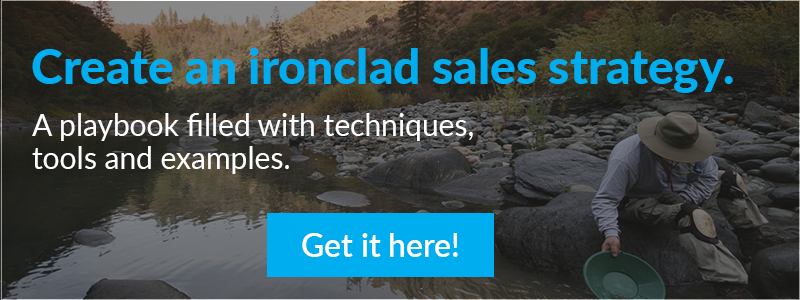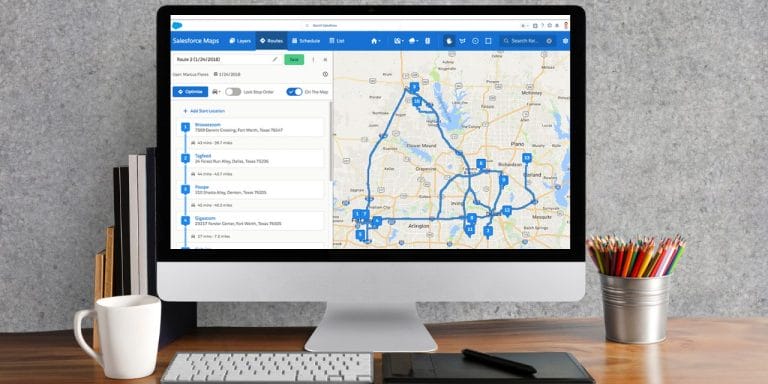Table of Contents
- What is sales prospecting?
- Leads, prospects, and opportunities
- 6 stats that proves the value of (efficient) sales prospecting
- 7 pillars of successful sales prospecting
- Who should be doing the sales prospecting?
- The anatomy of a rockstar sales prospector
- 5 sales prospecting techniques (by category)
- A repeatable 8-step sales process
- How often should you be sales prospecting?
- Sales prospecting tools
- Common prospecting objections (and how to overcome them)
Sales prospecting is often compared to panning for gold. A great analogy, in so many ways!
When sifting for gold, your success depends on three things:
- Knowing which rivers have the highest gold concentration;
- Having a capable team of panners, and;
- Having the right tools for the job.
Think about it — who’s coming home richer at the end of the day? The person panning aimlessly in a random river, or the wily expert with data on the most profitable rivers, equipment, and techniques?
Panning and prospecting have a lot in common. You start the day with a blank slate, and go in search of fortune by carefully extracting value from murky, ever-changing sources.
By the end of the day, an experienced panner could bring home up to 120 buckets of gold. A sales prospector, on the other hand, could have a big list of “ready-to-buy” contacts in the CRM.
Who’s to say which is more valuable?
OK:
Eager to fill your CRM with sales-ready leads? Before we get our hands dirty, let’s get crystal clear on what we’re talking about…
What is sales prospecting?
Sales prospecting is a key responsibility for any field sales rep.
The goal in the sales prospecting phase is to uncover new business opportunities – mainly done by making outbound calls and sending emails to contacts identified as prospects. Specifically, the leads likely to make a purchase decision.
The idea behind sales prospecting is rooted in efficiency. Organizations with fine-tuned sales processes split the responsibility of prospecting and deal-closing between dedicated teams, leaving account executives to sell, instead of wasting time trying to close unqualified leads.
A defined sales prospecting strategy fuels the entire B2B sales funnel — the more leads you pour in the top, the more customers should come out the bottom.
(Source)
To improve the sales funnel, it’s essential you understand the difference between leads, prospects and opportunities. How you identify, classify, and sell to each will form the basis of your entire sales strategy.
Definitions: Leads, Prospects and Opportunities
What is the difference between a lead and a prospect?
A simplified view:

(Source)
Any contacts acquired through manual research, inbound marketing or referrals is considered a lead. With a well-grounded lead generation strategy, you could have leads flooding in; but only a few of them are prospects.
The difference between a lead and a prospect is that a prospect is actually interested in what you’re selling.
That doesn’t necessarily mean they have the budget, decision-making authority, or willingness to buy right now, but it does mean they’re worth nurturing down the funnel in an attempt to eventually convert them into an opportunity.
At face value, this all sounds simple. But not all leads are created — or qualified — equally.
Leads come from different places; some from marketing channels and some from direct sales activities. Depending on the source and funnel stage, leads are at different qualification stages as they’re handed between sales and marketing.

Because of this, the qualification process can generally be broken down into two areas with two kinds of leads: marketing qualified leads (MQLs) and sales qualified leads (SQLs).
The difference between MQLs and SQLs

(Source)
Gaining reliable insight into leads at scale is difficult, but it has partially been solved by the advent of advanced marketing analytics tools, cross-platform tracking, and software which can build detailed lead profiles.
With analytics and tracking, it’s possible to understand which leads from your lists are the most engaged and likely to buy — these are your MQLs. You’re pretty confident they’re the right customer. They’ve qualified themselves by consistently showing interest in your marketing.
But, at its heart, sales is always going to be high-touch and rooted in manual, human-centric practices. The difference between an MQL and an SQL is that an SQL has directly expressed interest and been qualified by the sales team, rather than simply shown a promising pattern of behavior.
Prospecting sifts through the murky river water and returns only the solid-gold contacts.
With the right approach (which we’ll look at soon), you can use prospecting to make the sales team much more efficient, spending less time chasing dead ends and more time turning opportunities into dollars.
6 Statistics that Prove the Value of (Efficient) Sales Prospecting
Prospectors make between 100 and 500 calls for every lead they qualify
Nothing hammers home the ‘sifting through a river for gold’ metaphor more than this little nugget from SiriusDecisions. A success rate that sits somewhere between one and one-fifth of a percent indicates how rare a good prospect is, and, more importantly, how unlikely you are to get a bite when your lead list is about as tailored as the Yellow Pages
Considering that the average SDR makes 46 calls a day, it’s essential these 46 calls are going to the best contacts.
It takes 5-8 touches to generate a sales meeting
This reinforces the importance of follow up. The team getting 5-8 touches, consistently, is the team that’s going to see more opportunities coming out the bottom of the funnel.
Almost a third (31%) of buyers say manual, 1-to-1 prospecting with personalized messaging is very effective when they’re making a purchase decision, versus just 5% when compared to automated email.
Companies with well-defined sales processes have a win rate of over 50%
According to research from Salesforce, a high-performing sales organization = an organization with a documented sales playbook. Prospecting requires processes for things like lead research, managing relationships, doing qualification calls, and with these things in place — Salesforce data indicates — you’re 33% more likely to be a high-performing company.
7 Pillars of Successful Sales Prospecting
Prospecting is a needle-in-a-haystack game. That’s why it requires focus on:
The right contacts
… in the right companies
… with the right offer
And, not only that, you also need to consider the form and frequency of outreach, as well as how you plan on handling objections.
Breaking it down:
- Targeting
- Territories
- Right offer
- Multiple touches
- Variety of touches
- Scalable scripts
- Responses to objections
Targeting

(Source)
Targeting is the foundation of prospecting. It refers to who you contact in an organization, and how they align with your ideal customer profile.
A successful prospecting process will find people already evaluating competing solutions alongside people who are unaware your products exists. The sweet spot, according to RAIN Group, is somewhere in between — a lead that both recognizes a pain and is early enough to consider your solution a forerunner.
Territories
Your ideal territories need to be nailed down before you can start prospecting with precision. Your territory is the sum of your target’s industry, company size, purchase history, geographic location, and other specific factors.
By analyzing your historical sales data, you can identify territory trends — which are the highest performing territories? Why? By answering these questions, you can tighten up your prospecting process and better understand where to look and who to reach out to.
Right offer
A process should also be in place to make sure prospecting involves making the right offer. This is all about getting the angle right, and relating your product’s specific features to the prospect’s specific pain, explaining the benefits and what the product can positively change in their lives.

Multiple touches

(Source)
Your prospects are busy — bombarded by information, options, and competitors. Do you always catch an offer the first time round, or respond to every email without needing a follow-up?
No, and your prospects are no different. Planning sales plays that involve multiple touchpoints is essential considering most meetings happen after an average of 8 touches.
Variety of touches
Using a variety of touchpoints to reach prospects helps account for an individual’s preferred communication channels. Some prospects want to get on the phone, so a cold call might be better than a LinkedIn message, for example.
Scalable scripts
A script is the verbal, practical side of the sales process. It should answer common questions, introduce selling points, and handle objections responses. It should also be refined over time as specific questions and obstacles emerge in the selling process.
Responses to objections
When prospecting you should be prepared to tackle the tough questions. Identify and document solutions to common sales objections like “we love doing it all on paper, it’s easier to manage”, and “the analytics that come with WordPress are enough for us…”. When leads object to the sale after showing interest, they really just want to be proven wrong.
Include responses to common objections in your training documents for SDRs.
Who should be doing the sales prospecting?
Sales prospecting is the high-volume, endless treadmill of the sales department. In bigger organizations, it’s the job of a team of specialized prospectors, all armed with a carefully memorized playbook and 360 view of the funnel.
In a bootstrapped startup, this task is often performed by the CEO, as was the case with Stripe:
“More diffident founders ask “Will you try our beta?” and if the answer is yes, they say “Great, we’ll send you a link.” But the Collison brothers weren’t going to wait. When anyone agreed to try Stripe they’d say “Right then, give me your laptop” and set them up on the spot.”
Most businesses fall somewhere in between enterprise and startup, and the function of sales prospector should be clearly defined.
In the businesses that have a dedicated sales team (versus just a core group of founders), prospecting falls under the guise of sales development representatives (SDR).
According to RingDNA,
“[An SDR] solely focuses on outbound prospecting. Many companies (such as Salesforce) have experienced massive revenue growth by separating sales organizations into specific roles. Unlike quota-carrying salespeople, sales development reps don’t focus on closing business. Rather, SDRs focus on moving leads through the pipeline.“
Whatever your organizational size or structure — and whether you’re hiring an SDR or looking for a co-founder — there are four traits that define a rockstar sales prospector.
The Anatomy of a Rockstar Sales Prospector
- Deep customer knowledge (persona)
- Deep product knowledge
- Deep research skills
- Determination (it’s a grind)
Prospectors require the right skills and the right personality.
Here are four components to consider when hiring and training for the role:
Deep customer knowledge (persona)
A deep knowledge of your company’s customer profile is essential. Personas allow prospectors to understand the desires, fears, and objections of someone they wouldn’t otherwise be able to relate to, and haven’t met yet.
To make this work at scale, you’ll also need to make sure these persona documents are accurate and regularly updated.

Deep product knowledge
An efficient prospector will know the product inside out. There’s no way they can be effective at tying the product’s features to a customer’s needs if they don’t know how the product provides a solution.
One way to bake this into your sales onboarding process is to have all new employees do a run on customer support before they’re let loose in the sales field.
Research Skills
Knowing the difference between a company that does and doesn’t fall into your sales territory depends on whether the prospector has good research skills. The same goes for identifying the right contact inside an organization. Research can determine who that is (and give you a talking point that aligns with a specific pain point).
Grit
Let’s be honest. A prospector’s core personality trait — and something that is near impossible to train — is determination. Any task that has a success rate between one and one-fifth of a percent undoubtedly has days where it feels like a skull-numbing grind rather than an exhilarating chase. A rockstar prospector can stick it out in the toughest of times.
5 Sales Prospecting Techniques (by Category)
Prospects are on dozens of channels – online and offline. They find you through search, you find them at a trade show… and so on.
We’re going to look at a list of sales prospecting techniques, organized by category:
Field sales prospecting
Field sales prospecting means meeting with prospects in-person, either residentially for consumer products, or at a business location for B2B.
Capturing a prospect’s attention in person is obviously a powerful conversion force; salespeople can more easily build trust, convey personality, and read signals when face-to-face. B2B trade shows capitalize on this, and the numbers show. Over half of B2B trade show attendees request that an SDR from an exhibiting company comes to their office post-event.
Door to door sales is also making a comeback. Studies show that outside sales reps have a close rate 30% higher than inside sales, and tend to work deals that are 130% larger.

An all-in-one tool you can use to track, optimize and scale field sales prospecting is SPOTIO.
SPOTIO is a central dashboard and CRM for managing and executing field sales, featuring an interactive map of territories and lead location, detailed insights into prospects, and powerful reporting so you can focus outside sales teams on the strongest opportunities.
In conjunction with a way to manage the activity of your field sales team, you also need a way to reward and motivate them. Sales management and incentive tools like Ambition help you set and track goals for your sales teams, helping them to quantify their own work and stay keen to hit their targets.
Outbound sales prospecting
Outbound sales prospecting is one of the most powerful drivers of pipeline growth. Its goal is to cast a wide net and qualify (or disqualify) as many leads as possible in the shortest amount of time.
Because of this, it can deliver very few conversions if left unoptimized. SDRs can waste huge amounts of time calling on poor leads.
However, through cold calling and outbound email, it’s possible to use an informed, data-driven approach that is a powerful driver of Pipeline growth, in the case of Marketo:
“Within each account, we target anywhere from 3-5 different personas and decision-makers. This includes account profiling, email personalization, and maintaining follow-up tasks. A busy day indeed, but at the end of it all, we are driving significant pipeline contribution to the bottom line. In 2016, we added a 65% year-over-year growth in pipeline. “ — Ernesto Castillo
The best outbound prospectors can reach prospects where they’re active. That could mean on the office phone in the late morning, or over Twitter DMs.
The diversification of sales channels that has come with the increased availability of social media has forced outbound sales to evolve, but also given sales teams the opportunity to engage prospects where they want to be engaged.
When speaking to hundreds of leads each week, keeping tabs on relationship stage and the finer details of all the conversations can be impossible without the right software. SPOTIO’s Lead Management features are ideal for tracking the status of multiple leads and getting visibility over your pipeline.

When prospecting, you should also be using software to store scripts, checklists, and qualification questions. Prospecting over the phone can be easier if you have somewhere structured to take notes on the answers to qualification questions, and a place to reference scripts. You can record notes and the answers to qualification questions in SPOTIO custom fields, providing you with a way to combine qualification data with the existing lead profile.
Inbound marketing
When we talk about ‘inbound’, we’re referring to the channels by which leads find us. Inbound marketing relies on being visible, in the right places, to the right people. Outbound, on the other hand, involves proactively seeking out leads and engaging them.
Inbound marketing leverages a variety of different channels, including search engine optimization, automated email marketing, and social selling to passively nurture and convert leads at scale, without having to have personal correspondence with each prospect across every single touchpoint:

(Source)
For smaller businesses, inbound marketing is an appealing alternative to hiring a huge outbound sales force because one piece of well-positioned content can deliver value for years to come.
Content is becoming more vital for sales as customers conduct research alone, without the help or guidance of a salesperson. The power is now firmly in the hands of the buyer.
In fact, 90% of the buyer’s journey is over before the sales team gets involved. Content is your business’ silent salesperson, priming and nurturing leads as they go through the product research phase:
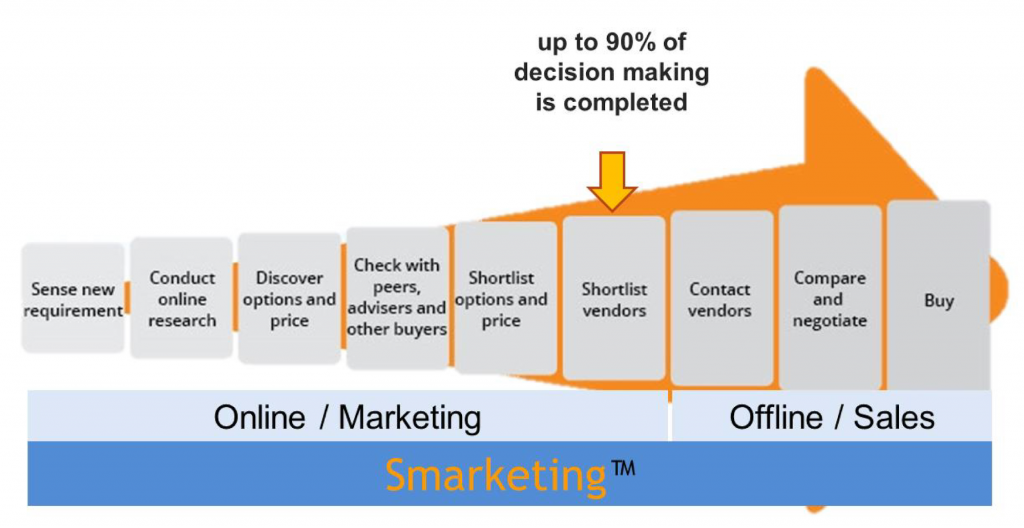
Inbound marketing will fuel the sales engine by pouring potential buyers into the top of the funnel. More targeted techniques like personalized drip campaigns can guide those leads towards the bottom of the funnel without ever engaging a sales rep.
Inbound is not siloed to the top of the funnel. It also aids the research phase of the buying cycle. Businesses can create fact sheets, competitor comparisons, and landing pages to answer questions prospects are asking during the research and evaluation phase of the buying cycle.
Due to the industry’s complexity, especially as the buyer’s journey gets longer, B2B companies stand to benefit from inbound marketing — those in the SaaS industry, especially.
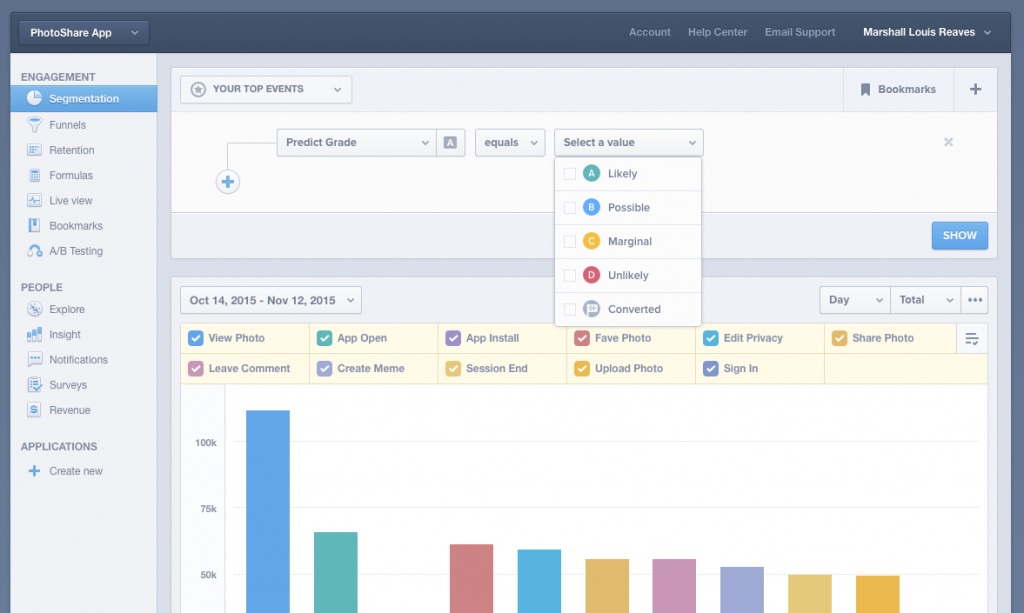
(Source)
Tools to assist with inbound marketing are wide-ranging, from analytics suites like Mixpanel which help measure the impact of marketing activity, to content calendar management tools like CoSchedule, which help to plan and orchestrate campaigns.
Networking
Network sales is a way to prospect by building and maintaining relationships at scale. Reps build leads by leveraging professional connections and networks. The idea is like a ripple effect for influence — if you gain the trust of one person, you can tap into their network, and the networks of those people, and so on.
Sales networks can be built and strengthened through trade events, and industry networks — even less formal channels like Slack channels, Facebook private groups, and Twitter chats.
Any industry that has professional events and gatherings is ripe for network sales; even contacts made that are only leveraged occasionally can create great value, as a research paper studying 282 professionals revealed when looking at the correlation between relationship strength and referral likelihood. The study found that 28% of referrals came from connections that were contacted once per year or less. Not close connections, but value-creating weaker ties.
And it’s possible to find these ties by using your industry keywords in event search tools like Eventbrite and Meetup.
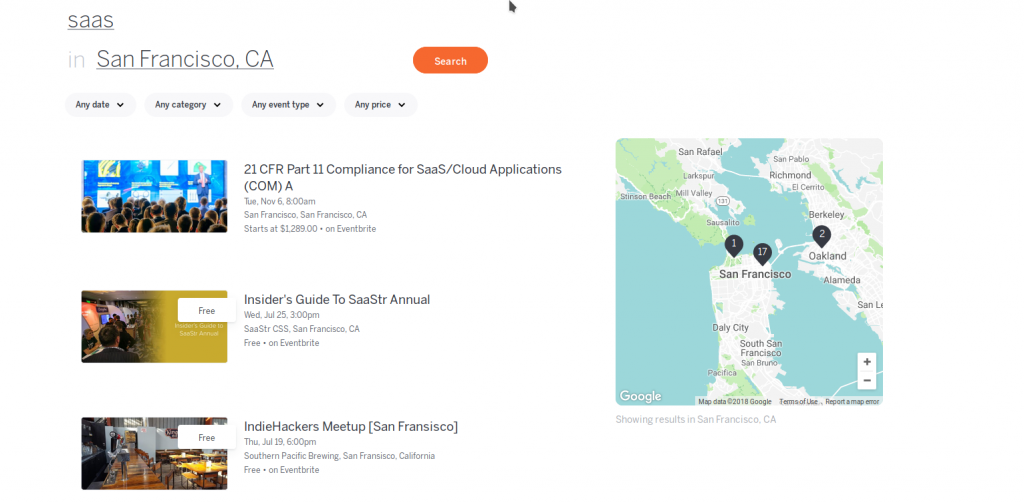
Referrals
Sales funnels are sometimes visualized with the customer conversion as the endpoint. However, referrals are the the other side of the story — a passive source of leads that is generated by happy customers, feeds the top of the funnel, and helps to accelerate conversion.
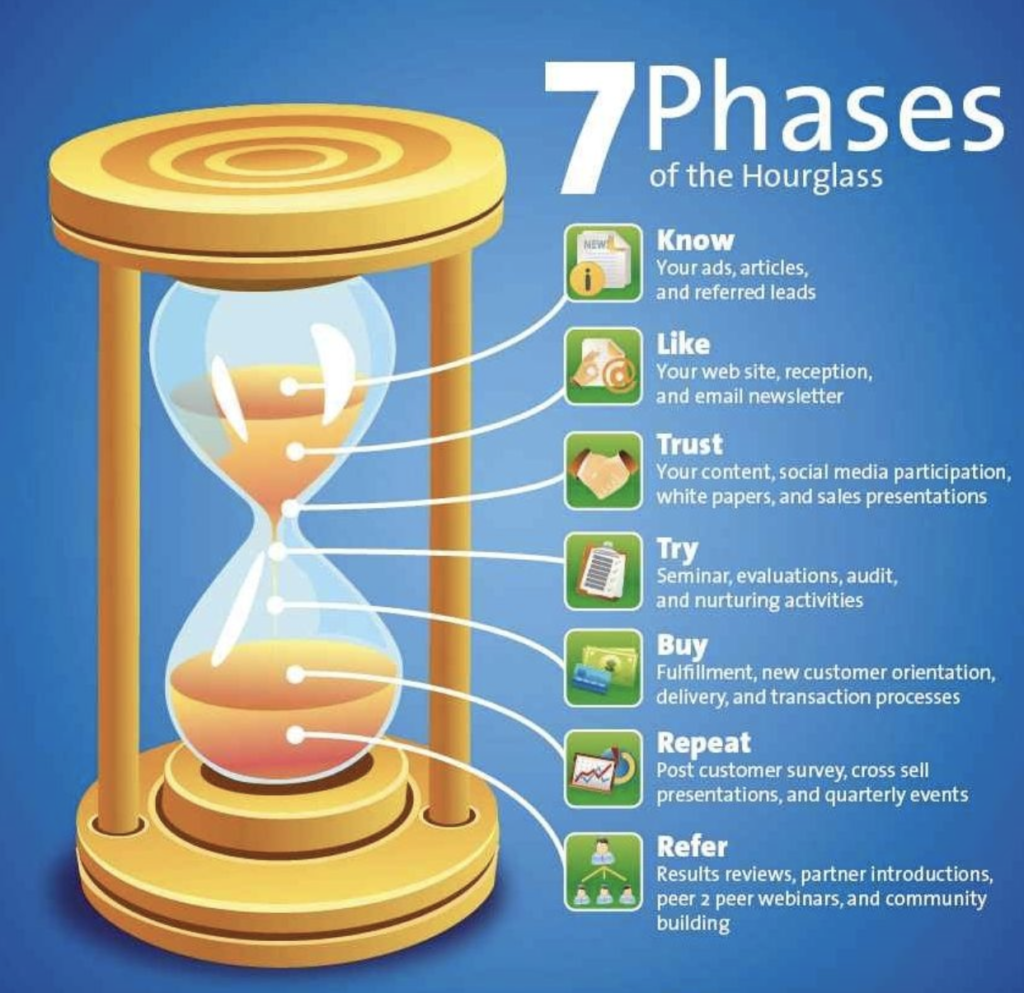
(Source)
While referrals are rooted in the idea that the customer evangelist will take care of the prospecting stage for you, it’s also important to be proactively generating referrals with product credit incentives, plan upgrades, or anything else you have to give.
Dropbox, for example, rocketed their growth by creating a viral loop with referrals, incentivized by extra megabytes of cloud storage.
To manage and use referrals to boost pipeline growth, you can use a tool like GrowSumo to develop an affiliate program. This will give your users (and influencers!) a personal stake in your success, and encourage them to promote your business across social media, email and other channels.
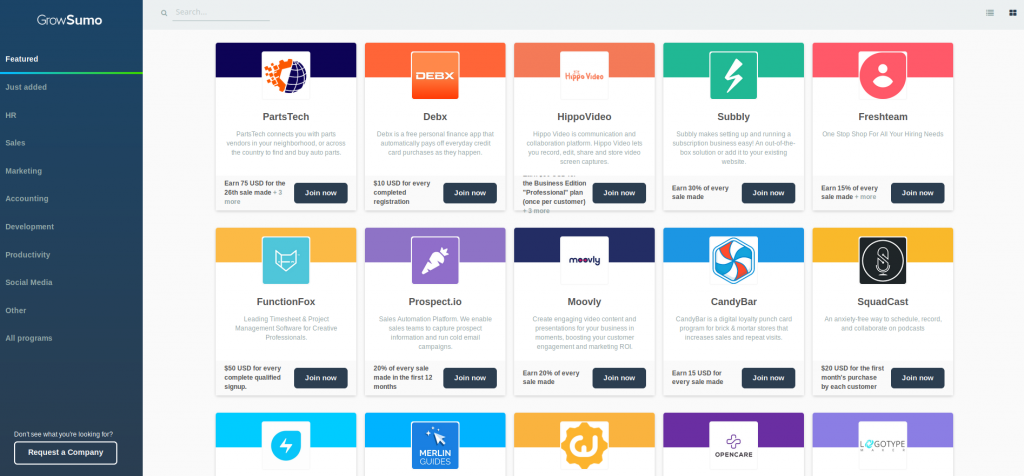
A Repeatable 8-Step Sales Prospecting Process
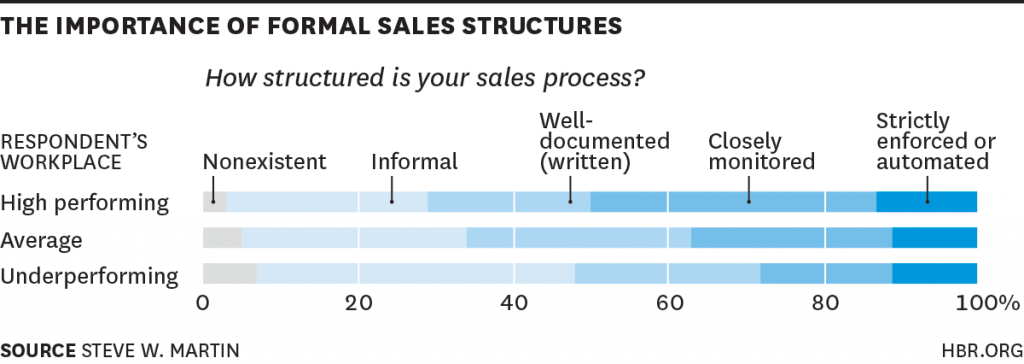
(Source)
There is a strong correlation between the highest-performing sales teams and the use of documented processes. In fact, companies with a formal sales process see up to a 28% boost in revenue.
Step #1: Research
Prospecting must be built on a solid foundation of planning — there’s no use going off half-cocked and burning through a list of poor leads when you could use those same hours to efficiently mine for gold.
The first step in the process is researching who the prospects are. This requires a solid set of personas, or target accounts/contacts:

(Source)
Tools and resources for prospecting include LinkedIn Sales Navigator, Crunchbase, or free options like Google Alerts.
For outside sales teams, SPOTIO’s Lead Machine helps reps build profiles and identify qualified prospects using 50 different demographic and firmographic data points:
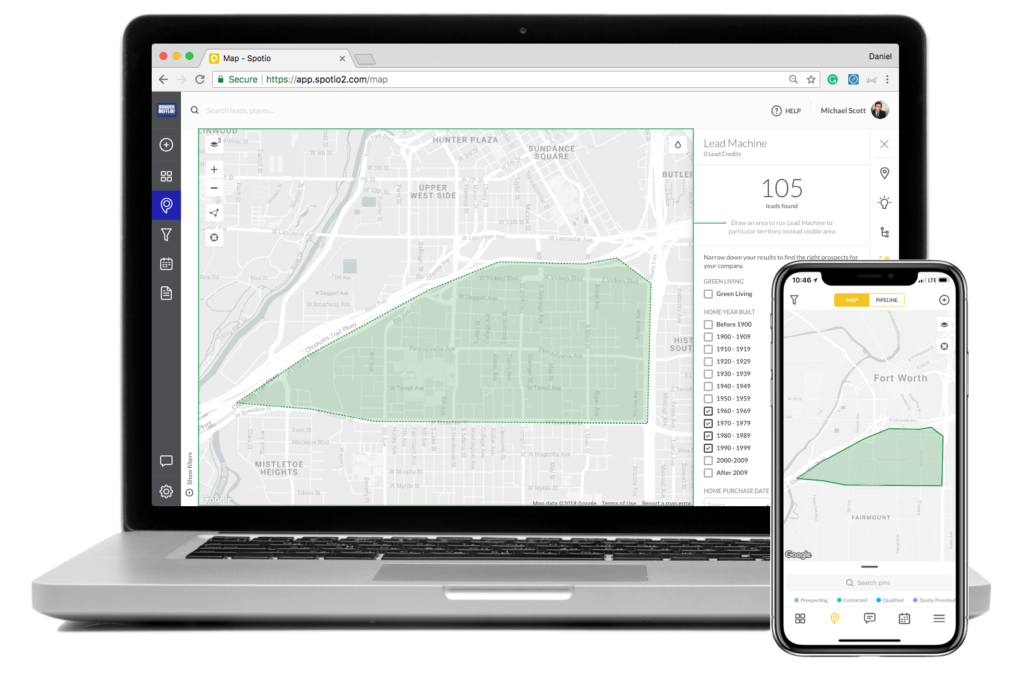
Step #2: Map
Once you know who your leads are, the next step is to find out where to reach them. SPOTIO’s territory mapping software makes this extremely easy for sales managers:
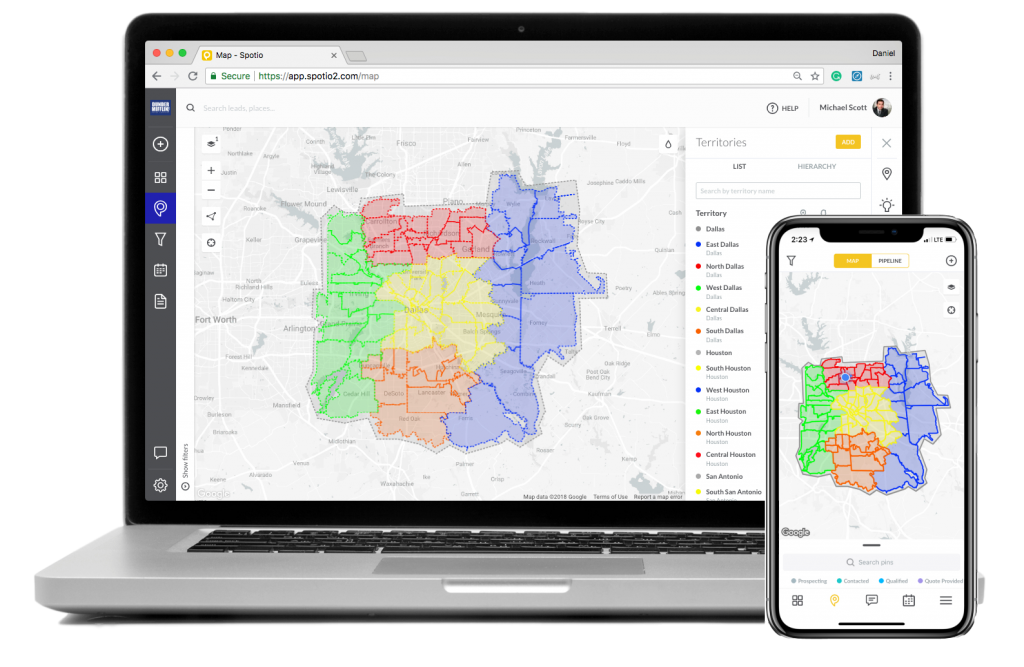
Assign the appropriate territories to individual reps on the sales team and cover a larger area in a shorter period of time.
Step #3: Build prospect lists
With company and territory plan in hand, you can now collate this information together with exactly which prospects and contacts you’re going to reach out to, and how.
This can be done by using filters in your CRM to create lists based on data like company size, activity, or potential deal size. With SPOTIO’s lead management software, you can easily build prospect lists based on territory, funnel stage, and historical data. The tool also allows users to geocode prospects onto a map for easy, visual segmentation.
Step #4: Plan outreach
How will you reach out and engage prospects? The purpose of the research you’ve done so far is to understand the lead’s pain, and position your product as the primary solution.

(Source)
Use notes or tags inside your CRM as an indication of the message and channels you’re going to use when it’s time to engage.
Step #5: Engage across multiple channels

Today’s buyer uses more channels than ever for research and communication with salespeople. The opportunities to reach and engage customers is endless.
Your sales process should include a multi-channel strategy, both to see which channels are best suited to which leads, as well as which sequence and combination of channels see the best conversions.
Step #6: Follow-up
A 2017 study into how the world’s top 250 SaaS companies chase leads found that companies will generally follow up for nine days, usually at a rate of one email per day.
Almost a quarter of these companies also followed up via voicemail, often to remind the lead of the benefits and make reference to a recently-sent resource or demo offer.
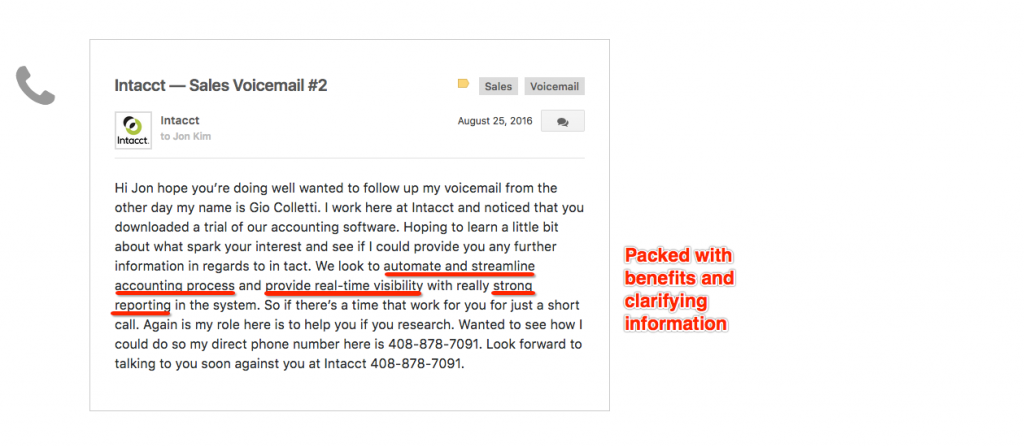
(Source)
Step #7: Evaluate
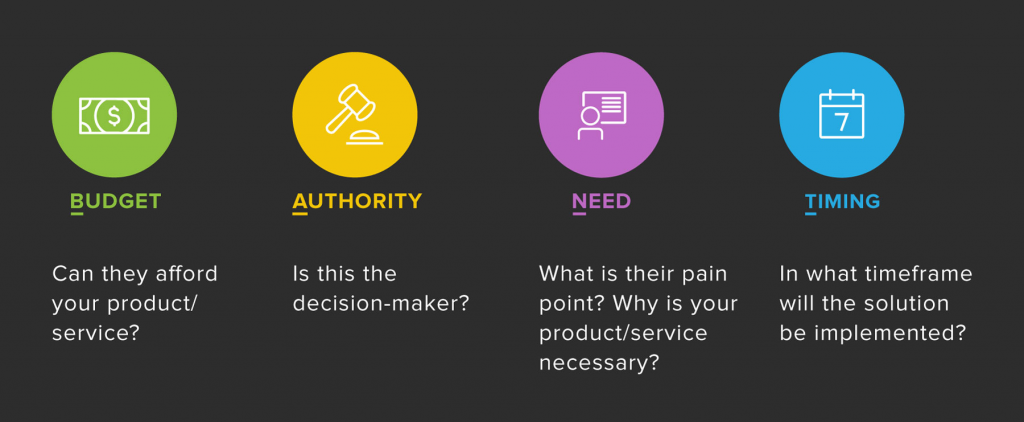
(Source)
With a list of leads and records of conversation history, you should now be able to evaluate traits of your highest quality leads and use them to inform future prospecting initiatives. To ensure this is done in a structured way, something like a BANT or MEDDIC framework helps make qualification decisions easier and formulaic.
Step #8: Ask for referrals
Forgetting to ask for referrals is the ultimate missed opportunity. Research shows people are four times more likely to buy when referred by a friend, and that 83% of consumers are willing to give you a referral, yet only 29% actually do. That’s a big gap you could take advantage of by using a deliberate approach to asking for referrals — or simply remembering to.
How Often Should You Be Sales Prospecting?
Let’s face it, unless you’re selling to a very niche market with with a small total addressable market, you should always be prospecting.
The “golden rule” states that you should have 3-5X pipeline coverage. That means you should aim to fill your pipeline with 3-5 times as many leads as you expect to close, to account for lost deals and bad fits:
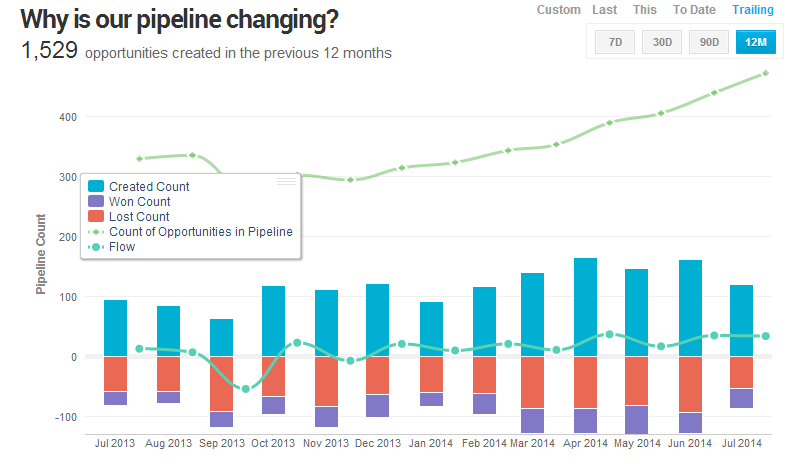
An example pipeline report from InsightSquared.
Sales Prospecting Tools
1. LinkedIn Sales Navigator

(Source)
For exploring a lead’s professional connections, background, and position, LinkedIn is one of the most popular tools in the game. Its Sales Navigator product allows you to build targeted lists of prospects based on defined criteria.
LinkedIn Sales Navigator would fit perfectly into the early stage of the sales prospecting process, with its powerful search and filtering capabilities will help you extract the most qualified prospects from the haystack.
2. SPOTIO (for field sales)
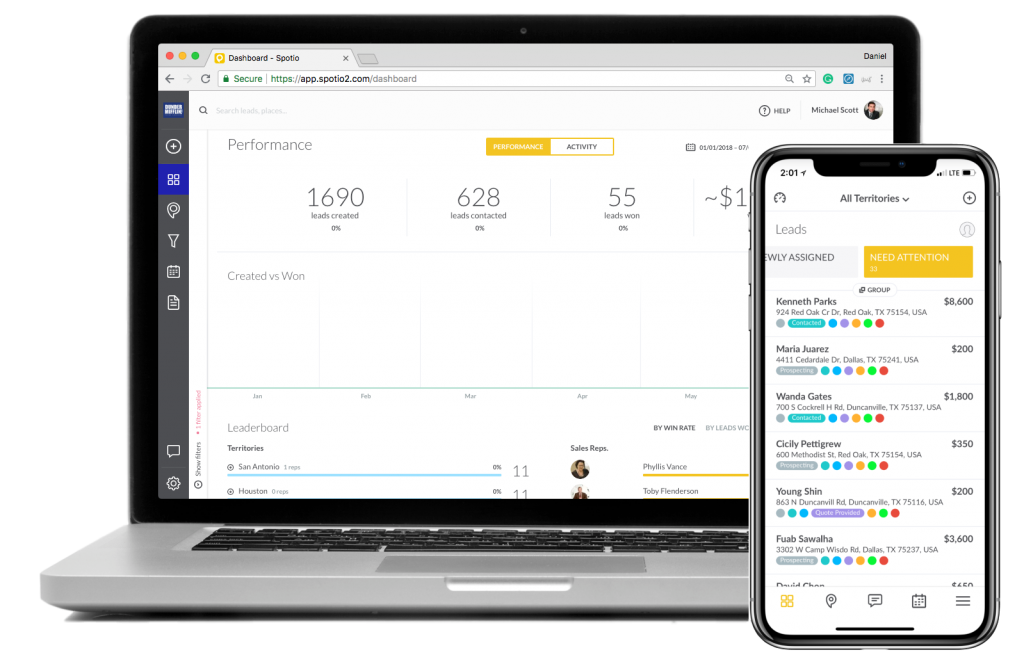
SPOTIO is a field sales management tool designed for on-the-go salespeople to plot the best routes and territories and reach the most leads in the least amount of time.
It features powerful filters to help your sales force narrow their lead list and focus only on the most high-converting personas.
3. Sellhack

SellHack is a sales prospecting tool that lets you upload lists of names and find more information about the contact, such as their email address and social profiles.
This is another tools that shines in the research phase; instead of manually researching your prospects (e.g. going down the rabbit hole and spending too long picking around for information), you can quickly grab their contact information and other vital data with this Chrome extension.
4. CRM

Your CRM forms the centerpiece of your sales stack. It contains lead contact information, and is essential for tracking the status of sales across the team, so individual reps can better manage and nurture relationships.
When it comes to prospecting, your team’s CRM data can be enriched from comprehensive external databases using tools like Clearbit, which displays metrics like company size and industry right next to the call and email history, giving reps context when they call.
5. Datanyze
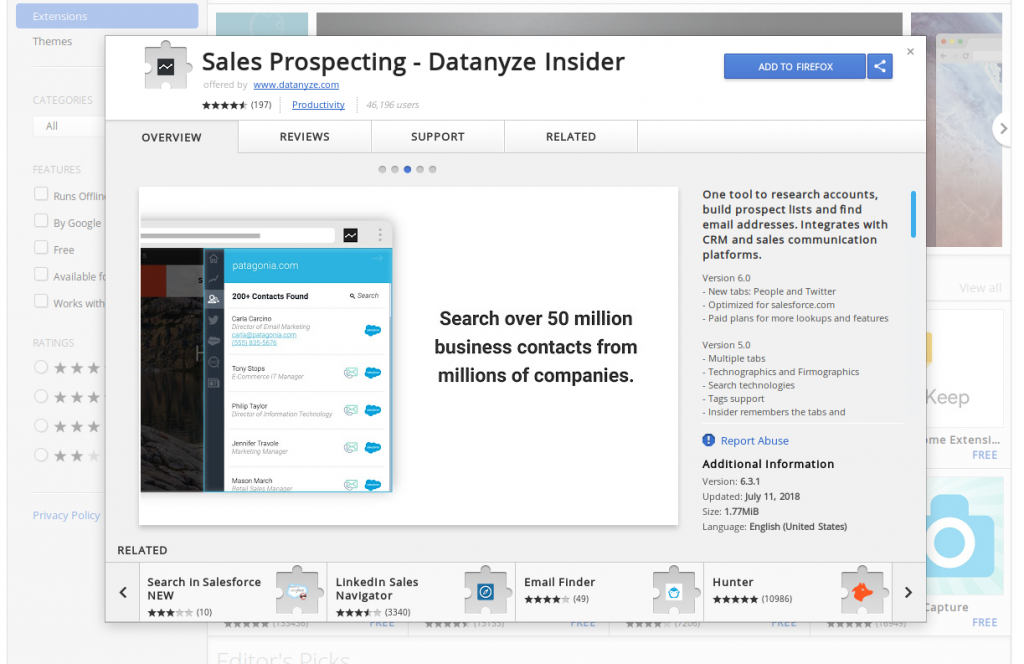
As well as offering CRM data enrichment, Datanyze also provides a browser extension designed to help reps prospect efficiently.
It does this by finding information both about the people behind the business (your target contacts) and analyzing the company’s technology stack. This makes it ideal for technology companies looking to sell a solution to a competitor’s current customers.
6. NerdyData
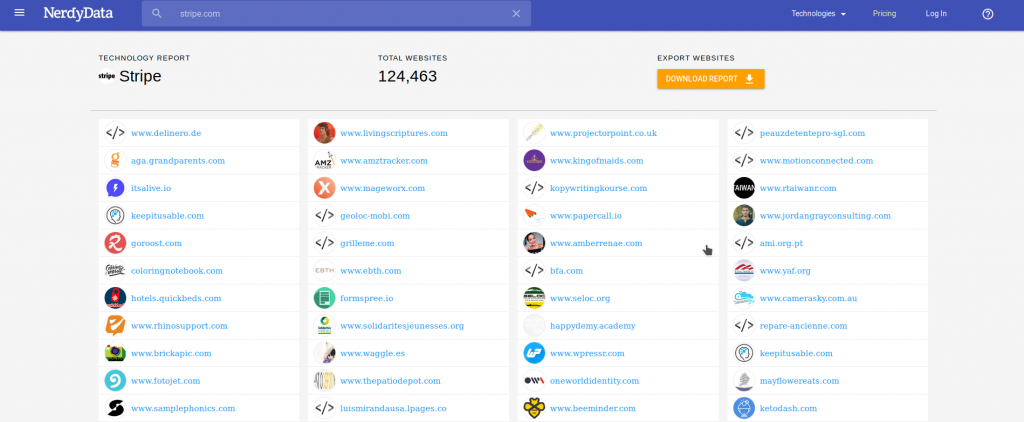
NerdyData is a pure prospecting tool, specifically designed for software companies to identify leads by the technology they are already using. This is effective because the technology a company uses is an indication of its maturity, intent, and preferred brands. This information can qualify or disqualify a lead early on.
7. Norbert
Norbert is an email-finding tool with an 87% success rate.
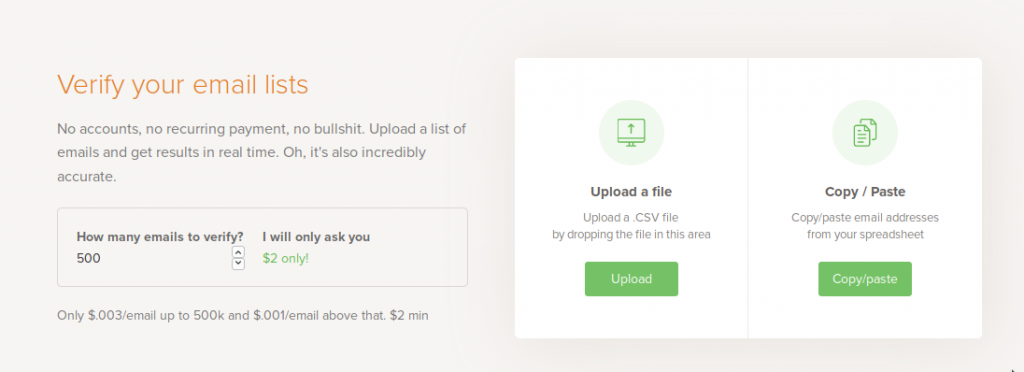
Bulk verify email lists, or enriched data from sources such as social media and LinkedIn.
8. Ghostery
While Ghostery is aimed at privacy-concerned individuals trying to block ad trackers, it also serves an interesting secondary purpose — especially interesting for SaaS prospectors.

When Ghostery blocks a tracking element on a page, it displays what exactly it blocked. With that information, you can see the technology being used on a prospect’s website, and enter the conversation knowing what you’re up against.
9. SPOTIO Appointment Calendar
Store your sales meeting events in the same place as your leads and manage the entire team’s schedule with SPOTIO’s appointment calendar:
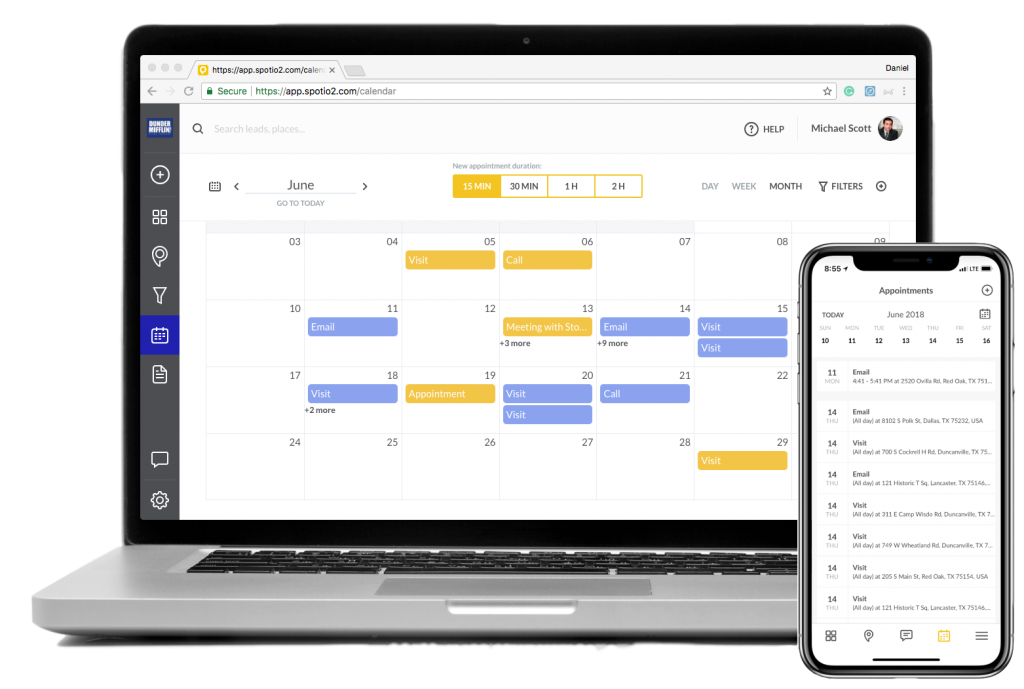
Schedule conflicts can kill momentum at this stage of the sales cycle, so be sure your team is managing their meetings effectively by using a collaborative, sales-focused calendar.
11. Hemingway Editor
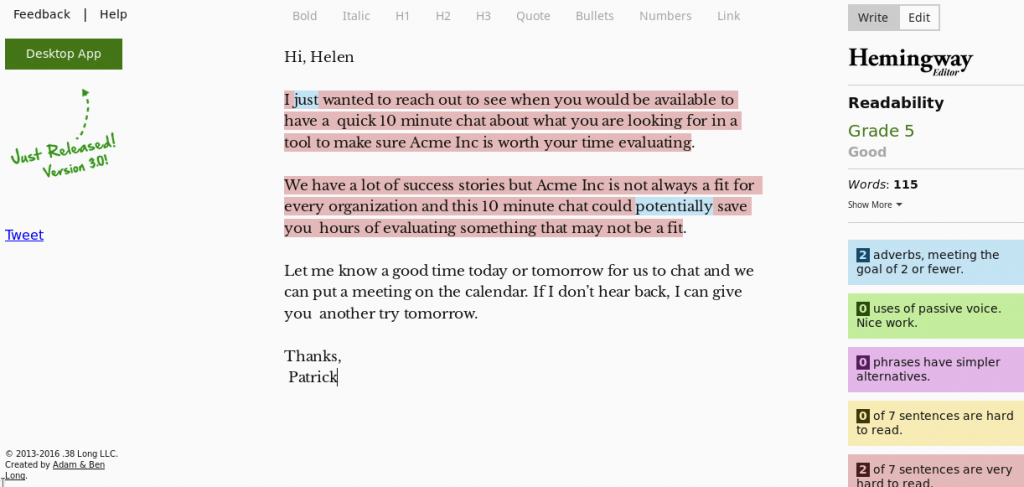
Hemingway is a brutal proofreader that forces you to tighten up your sales copy by simplifying sentences, reducing word complexity, and removing filler words.
Run your prospecting email templates and call scripts through Hemingway before you start the process; it doesn’t cost anything, or take much time to trim the fat and write higher converting emails.

Help make the prospecting meeting process as frictionless as possible by using a conference tool like Uberconference. Get into a meeting in seconds. — there’s nothing for users to download or sign up to, and it’s free!
Common Prospecting Objections (and How to Overcome Them)
Preparing for objections should be built into your sales prospecting scripts and templates, but to get started with that we’ve prepared a few of the most common objections, and how to deal with them
“I’m too busy right now”
The prospect is trying to get you off the phone. Converting a “too busy” objection into a rescheduled meeting could be as simple as asking for 20 seconds to make the case as to why you can bring value to the lead, and having them decide if they want a call back.
“I need more information to make this decision”
This form of objection can be overcome with a little bargaining. Of course, you want to be the company giving this lead more information, not a competitor. And giving the lead the time to research means they’ll be on the email nurturing list of your five closest competitors before you know it. After that, who knows what will happen? Instead of agreeing and forwarding on some one-size-fits-all information, make the case that you need to know a little more about the lead first, so you can send over material that will tailored to their needs.
“We’re already quite far along with your competitor…”
This one can be a real pain. They’re facing pressure from both sides, and — rational decisions aside — could be unwilling to back out of a deal they’re already progressing with. Present success stories and case studies from customers that switched away from that particular competitor, or offer to show the ways you are explicitly different
Read this guide for a more comprehensive look at common sales objections, and how to overcome them.
Conclusion
Maybe you’re a mid-sized team just starting to feel the need for a more process-driven approach to prospecting that will improve the health of your pipeline. Maybe you’re a founder madly hunting for new business for a startup. Maybe you’re a manager looking to level up output across your sales team?
Whatever the stage, prospecting is going to fuel your success.
Start today by using the right tools to proactively build and engage prospect lists. Innovate with the right processes in place, and take an attitude of continuous improvement to the way your team works.
____
Questions or comments? Contact SPOTIO at [email protected] or comment below.
SPOTIO is the #1 field sales automation and performance management software that will increase revenue, maximize profitability, and boost sales productivity.
Want to see a product demonstration? Click here to see how SPOTIO can take your sales game to the next level.

